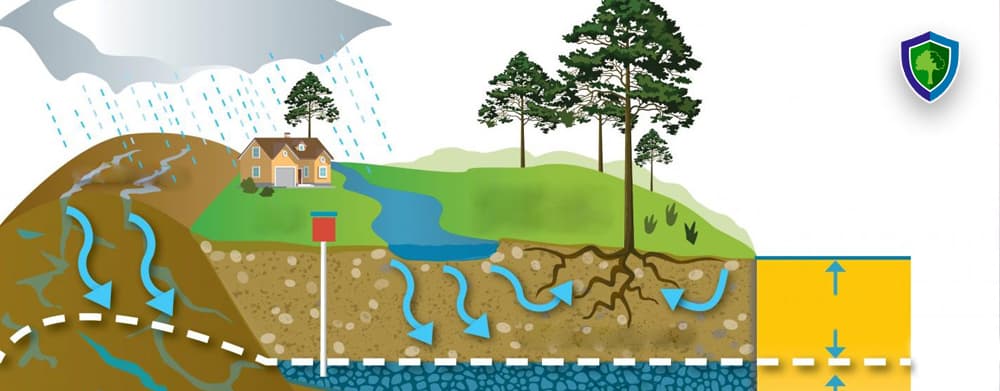
Water, land and underground resources

Information about areas of activity
1. Protection of water resources from various types of pollution using water-saving technologies (circulating water supply, multiple sequential use, etc.), monitoring compliance with water resource protection and water use rules.
2. Approval of standards for permissible limits of pollutant discharges into the environment.
3. Title documents of legal entities and individuals:
– established limits and standards for permissible discharges of pollutants into the natural environment and agreed measures to reduce discharges to established standards;
– environmental regulations, standards and requirements for the placement, design, construction and operation of new and reconstructed enterprises and other facilities;
– rules for the use of water protection structures, water management systems, reservoirs and other hydraulic structures;
– primary accounting of water resource use by nature users, discharges of pollutants;
– use of water resources, compliance with established norms, rules and water use regimes, protection of surface and groundwater from pollution, contamination and depletion, as well as in the coastal strip (zone) of water bodies, implementation of state control over the implementation of water protection measures in accordance with the law.
4. Preparation of proposals for draft concepts, main directions and state plans for environmental and socio-economic development of the Republic of Uzbekistan.
5. Participation in the preparation of long-term state and target programs for environmental protection and rational use of natural resources.
6. In the field of water resources protection and their rational use, coordination of the activities of specially authorized state bodies, intersectoral management of environmental activities.
7. Territorial inspectorates for land and subsoil protection, water resources protection and their rational use:
– compliance with the rights and legitimate interests of legal entities and individuals, ensuring their environmental protection and rational use of water resources;
8. Protection of land resources from water and wind erosion, floods, inundation, swamping, secondary salinization, drying out, compaction, industrial waste, pollution with chemical and radioactive substances and other degradation processes.
9. In accordance with the procedure established by law, legal entities and individuals:
– environmental regulations, standards and requirements for the placement, design, construction and commissioning of new, reconstructed and other facilities;
– pollution, littering and depletion of the environment during extraction, blasting operations, placement and use of waste storage facilities, waste heaps, dumps and landfills as a result of mining and enrichment activities, collective use of natural resources;
– norms and rules for the development of common minerals;
– environmental requirements for the transportation, storage and use of plant protection products, growth stimulants, mineral fertilizers, other chemicals and preparations;
– landowners and land users use land plots in accordance with established purposes and implement soil protection measures;
– implementation of state control over the subsequent rehabilitation of temporarily used lands damaged during construction, mining and other impacts.
10. Issuance of licenses for the right to use underground areas for the construction and use of underground structures for the purpose of storing and burying waste.
11. Inter-sectoral management of environmental protection activities in the field of land protection and common minerals, coordination of the activities of specially authorized state bodies.
12. Methodological guidance and coordination of the activities of regional inspectorates in the field of land and subsoil protection:
– ensure compliance with the rights and legitimate interests of legal entities and individuals, fulfill their obligations in the field of environmental protection and rational use of natural resources;
– inform the state, other organizations and citizens about changes in the environment, forecasts of its condition, the use of natural resources and the relevant measures taken;
– improve the efficiency of environmental protection activities, ensure the participation of citizens' self-government bodies, non-governmental non-profit organizations and citizens in the implementation of state and other environmental programs;
– provision of public services, including to business entities, on the "single window" principle;
– implementation of government decisions and their implementation.
13. Control and coordination of the implementation of measures to prevent or limit the negative impact on agriculture, forestry and other land resources during mineral extraction, as well as the implementation of reclamation work.
14. Participation in the development of regulatory legal documents in the field of land and subsoil protection.
– implementation of state control over the subsequent rehabilitation of temporarily used lands damaged during construction, mining and other impacts.
15. Issuance of licenses for the right to use subsoil areas for the construction and use of underground structures for the purpose of storing and burying waste in accordance with the established procedure.
16. Intersectoral management of environmental protection activities in the field of land and common minerals protection, coordination of activities of specially authorized state bodies.
17. Methodological management and coordination of activities of regional inspectorates in the field of land and subsoil protection:
– ensure compliance with the rights and legitimate interests of legal entities and individuals, fulfill their obligations in the field of environmental protection and rational use of natural resources;
– inform the state, other organizations and citizens about changes in the environment, forecasts of its condition, use of natural resources and relevant measures taken;
– improve the efficiency of environmental protection activities, ensure the participation of citizens' self-government bodies, non-governmental non-profit organizations and citizens in the implementation of state and other environmental programs;
– provision of public services, including to business entities, on the "single window" principle;
– implementation of government decisions and their implementation.
18. Monitoring and coordinating the implementation of measures to prevent or limit the negative impact on agriculture, forestry and other land resources during the extraction of minerals, as well as the implementation of reclamation work.
19. Participation in the development of regulatory legal documents in the field of protection of land resources and subsoil.


